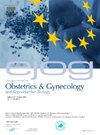Implementation of enhanced recovery after surgery in gynaecologic oncology surgery: where should we start?
IF 1.9
4区 医学
Q2 OBSTETRICS & GYNECOLOGY
European journal of obstetrics, gynecology, and reproductive biology
Pub Date : 2025-10-02
DOI:10.1016/j.ejogrb.2025.114752
引用次数: 0
Abstract
Purpose
Compliance with elements of an enhanced recovery after surgery (ERAS) protocol is associated with better outcomes, including decreased length of hospital stay (LHS), but complete implementation is challenging. This study aimed to identify the role of individual ERAS elements on LHS to facilitate the implementation process.
Methods
This retrospective single-centre study included 233 women with gynaecological cancers who underwent surgery between 1 February 2021 and 31 July 2023. The first 120 consecutive patients after implementation of the ERAS programme were defined as the ERAS group, and the other patients were in the pre-ERAS group. The groups were compared in terms of LHS. Univariate and multi-variate analyses were used to define independent predictors of decreased LHS (≤5 days).
Results
The median LHS was 6 [interquartile range (IQR) 1–29] days for the ERAS group and 7 (IQR 3–23) days for the pre-ERAS group (p = 0.006). Avoidance of mechanical bowel preparation (p = 0.007), avoidance of surgical site drainage (p < 0.001), removal of urinary drainage before postoperative day 3 (p = 0.02), regular diet initiation on postoperative day 0 (p = 0.02), and reduction in total opioid dose (p = 0.006) were significantly associated with LHS ≤ 5 days on univariate analysis. On multi-variate analysis, avoidance of surgical site drainage (p = 0.014), removal of urinary drainage before postoperative day 3 (p = 0.037), and reduction in total opioid dose (p = 0.045) remained significant for LHS ≤ 5 days.
Conclusion
Avoidance of surgical site drainage, removal of urinary drainage before postoperative day 3, and reduction in total opioid dose were found to be independent predictors of decreased LHS among ERAS items. Special consideration should be given to these items during the adoption of ERAS programmes.
在妇科肿瘤手术中实施增强术后恢复:我们应该从哪里开始?
目的:术后增强恢复(ERAS)协议的遵守与更好的结果相关,包括缩短住院时间(LHS),但完全实施是具有挑战性的。这项研究的目的是确定个别的电子废物回收系统在土地卫生系统中的作用,以促进实施过程。方法本回顾性单中心研究纳入了在2021年2月1日至2023年7月31日期间接受手术的233名妇科癌症患者。实施ERAS计划后的前120例连续患者被定义为ERAS组,其他患者被定义为ERAS前组。比较各组的LHS。采用单因素和多因素分析确定LHS下降(≤5天)的独立预测因子。结果ERAS组的中位LHS为6[四分位间距(IQR) 1 ~ 29]天,ERAS前组的中位LHS为7 (IQR 3 ~ 23)天(p = 0.006)。单因素分析显示,避免机械肠道准备(p = 0.007)、避免手术部位引流(p < 0.001)、术后第3天前清除尿路引流(p = 0.02)、术后第0天开始规律饮食(p = 0.02)、减少阿片类药物总剂量(p = 0.006)与LHS≤5天显著相关。多因素分析显示,在LHS≤5天,避免手术部位引流(p = 0.014)、术后第3天清除尿路引流(p = 0.037)和减少阿片类药物总剂量(p = 0.045)仍然具有显著性。结论避免手术部位引流、术后第3天清除尿路引流、减少阿片类药物总剂量是ERAS项目中LHS下降的独立预测因素。在通过紧急恢复方案时,应特别考虑到这些项目。
本文章由计算机程序翻译,如有差异,请以英文原文为准。
求助全文
约1分钟内获得全文
求助全文
来源期刊
CiteScore
4.60
自引率
3.80%
发文量
898
审稿时长
8.3 weeks
期刊介绍:
The European Journal of Obstetrics & Gynecology and Reproductive Biology is the leading general clinical journal covering the continent. It publishes peer reviewed original research articles, as well as a wide range of news, book reviews, biographical, historical and educational articles and a lively correspondence section. Fields covered include obstetrics, prenatal diagnosis, maternal-fetal medicine, perinatology, general gynecology, gynecologic oncology, uro-gynecology, reproductive medicine, infertility, reproductive endocrinology, sexual medicine and reproductive ethics. The European Journal of Obstetrics & Gynecology and Reproductive Biology provides a forum for scientific and clinical professional communication in obstetrics and gynecology throughout Europe and the world.

 求助内容:
求助内容: 应助结果提醒方式:
应助结果提醒方式:


